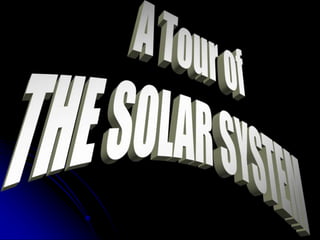
Tour of solar_system
- 3. Components of the Solar System It was formed five thousand millions years ago from gas and dust of a nebula. - A medium-sized star. - Planets - Dwarf planets - Satellites - Asteroids - Comets
- 4. The Sun The Sun is a huge sphere of gas. It is mostly made up of hydrogen (74%) and helium (24%). It is 4,500 million years old It takes 8 minutes for its light to reach the Earth. 98.6% mass of the Solar System. • Radius: 695,000 km • Mass: 333,000 Earths! • Surface Temperature: 5,500 °C • Core Temperature: 15,500,000 °C
- 6. THE PLANETS AND THEIR ORBITS There are 8 planets in the Solar System that are classified into two groups: the inner or terrestrial planets and the outer or gas giant planets.
- 7. All the planets experience two different movements: - Rotation on their own axis. - Revolution around the Sun where the planets describe closed paths, called orbits.
- 8. Mercury Smallest planet and closest to the Sun. No satellites. Lots of craters on its surface. It has no atmosphere so the day and night temperatures vary widely; temperatures reach 450°C during the day and at night, the temperature drop to -170°C. • It has a very long day due to its slow rotation, which is equal to 59 Earth days.
- 9. Mercury Earth Size Comparison
- 10. Venus Similar size and density to Earth. No satellites. Atmosphere composed of carbon dioxide and thick clouds of drops of sulphuric acid. Surface temperatures are a constant 500°C, the highest surface temperature in the solar system. Venus rotates in the opposite direction to other planets in the Solar System. • One day in Venus lasts more than one Earth year
- 11. Thick cloud atmosphere coveringVenus Mountain ranges on Venus taken with Radar.
- 12. Earth It is the 5th planet in size of the Solar System and the biggest of the inner planets. Radius: 6,400 km Mass: 5.8 x 1024 kg Temperature: -80 to 60 °C, average surface temperature is 15ºC Distance from Sun: 146 million km (1 AU) Surface is 70% covered by water. Atmosphere is made up of oxygen (21%) and nitrogen (78%). One natural satellite (the Moon) Over 2200 manmade satellites in orbit
- 13. Mars Very similar to our planet; its surface resembles the Earth´s rocky deserts. Thin atmospheric layer with 95% carbon dioxide. Surface temperatures are between 20ºC and -80ºC. Has the highest mountain in the Solar System – the Olympus Mons Volcano (25km high, equal to 2.5 times the Everest). • It has two small rocky satellites: Phobos and Deimos.
- 14. Recent discoveries suggest the possibility of water in the surface of Mars, between 1.5 and 3%.
- 15. Size comparison of the Inner Planet As seen in the images, Venus and the Earth are quite similar in size.
- 16. Asteroid Belt • Located between Jupiter and Mars. •Because the strong gravitational force of Jupiter they never merged to form a planet.
- 17. Ceres – a dwarf planet in the belt of asteroids Gaspro – a 400km-long asteroid
- 18. Jupiter Gas giant made up of 90% hydrogen, 10% helium, with a rocky core. It´s the biggest planet in the Solar System (mass is equal to 318 Earths) Great Red Spot – a storm that is located in the southern part of the planet with a distinctive shape. It has 4 large satellites which were discoverded by Galileo Galilei and 60 small ones.
- 20. Time-lapse animation from Voyager I on approach to Jupiter.
- 21. Io – The most volcanically active object in the Solar System. Europa – ice- covered moon that may harbour life.
- 22. Saturn Gas giant made of 75% hydrogen, 25% helium, with a rocky core and liquid hydrogen mantle. Second biggest planet in the solar system. It has a spectacular ring system that consists of 9 continuous rings made of ice, small rocks and dust particles. Has over 34 known moons, the biggest one called Titan. •
- 23. Saturn’s Rings. Mimas – a small moon of Saturn
- 24. Uranus Gas giant composed of hydrogen, helium and methane. Has more than 25 satellites It is very far from the Sun, so it is a frozen planet: surface temperature of -214°C Coldest atmosphere in the Solar System. It also has a ring system but it is not as big as Saturn´s .
- 25. Neptune Furthest away planet from the Sun. It is the planet with the fastest winds. Gas giant made of hydrogen, helium and methane. It is also a frozen planet, with very low surface temperatures, but the temperature inside Neptune is hot because it releases heat. 14 satellites, Triton is very large. • Distance from Sun: 4500 million km (30 AU)
- 26. Kuiper Belt • 30 to 55 AU • Like the asteroid belt but consisting of debris made of ices. •Biggest bodies are Pluto and Eris.
- 27. Pluto Downgraded from ‘planet’ to ‘dwarf planet’ in 2006 Smaller than the Moon Has 3 known satellites.